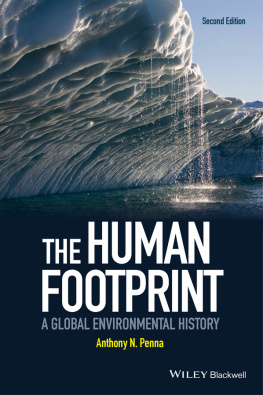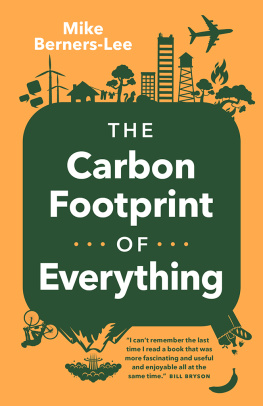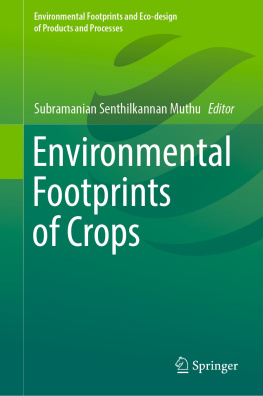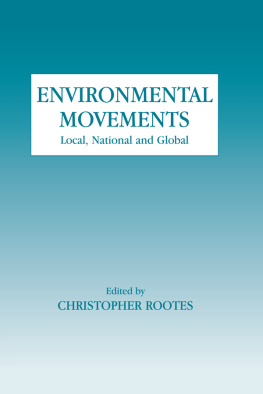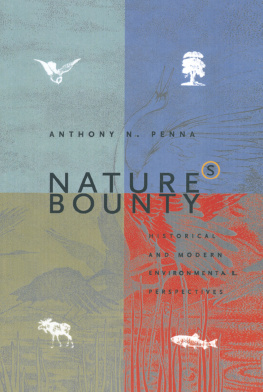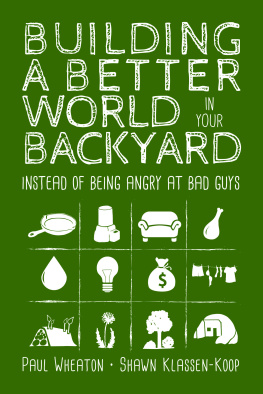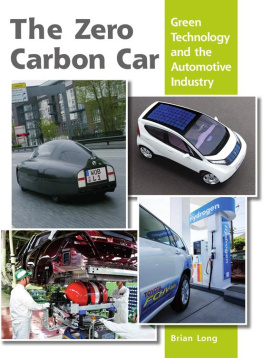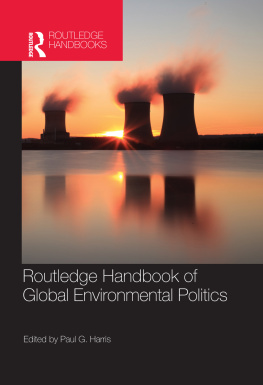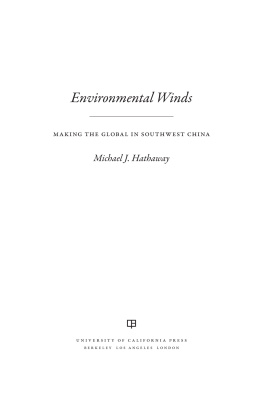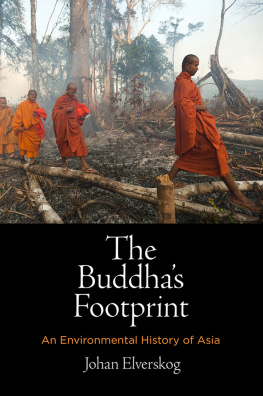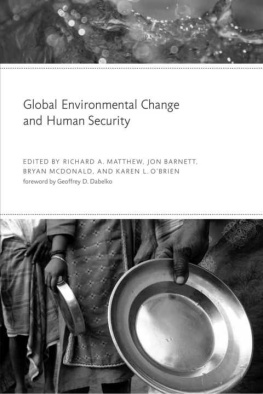Penna - The human footprint: a global environmental history
Here you can read online Penna - The human footprint: a global environmental history full text of the book (entire story) in english for free. Download pdf and epub, get meaning, cover and reviews about this ebook. City: Chichester;Malden;Oxford, year: 2015;2014, publisher: Wiley Blackwell, genre: Romance novel. Description of the work, (preface) as well as reviews are available. Best literature library LitArk.com created for fans of good reading and offers a wide selection of genres:
Romance novel
Science fiction
Adventure
Detective
Science
History
Home and family
Prose
Art
Politics
Computer
Non-fiction
Religion
Business
Children
Humor
Choose a favorite category and find really read worthwhile books. Enjoy immersion in the world of imagination, feel the emotions of the characters or learn something new for yourself, make an fascinating discovery.
- Book:The human footprint: a global environmental history
- Author:
- Publisher:Wiley Blackwell
- Genre:
- Year:2015;2014
- City:Chichester;Malden;Oxford
- Rating:4 / 5
- Favourites:Add to favourites
- Your mark:
- 80
- 1
- 2
- 3
- 4
- 5
The human footprint: a global environmental history: summary, description and annotation
We offer to read an annotation, description, summary or preface (depends on what the author of the book "The human footprint: a global environmental history" wrote himself). If you haven't found the necessary information about the book — write in the comments, we will try to find it.
Penna: author's other books
Who wrote The human footprint: a global environmental history? Find out the surname, the name of the author of the book and a list of all author's works by series.
The human footprint: a global environmental history — read online for free the complete book (whole text) full work
Below is the text of the book, divided by pages. System saving the place of the last page read, allows you to conveniently read the book "The human footprint: a global environmental history" online for free, without having to search again every time where you left off. Put a bookmark, and you can go to the page where you finished reading at any time.
Font size:
Interval:
Bookmark:

This second edition first published 2015
2015 John Wiley & Sons, Inc
Edition history: John Wiley & Sons, Inc (1e, 2010)
Registered Office
John Wiley & Sons Ltd, The Atrium, Southern Gate, Chichester, West Sussex, PO19 8SQ, UK
Editorial Offices
350 Main Street, Malden, MA 02148-5020, USA
9600 Garsington Road, Oxford, OX4 2DQ, UK
The Atrium, Southern Gate, Chichester, West Sussex, PO19 8SQ, UK
For details of our global editorial offices, for customer services, and for information about how to apply for permission to reuse the copyright material in this book please see our website at www.wiley.com/wiley-blackwell.
The right of Anthony N. Penna to be identified as the author of this work has been asserted in accordance with the UK Copyright, Designs and Patents Act 1988.
All rights reserved. No part of this publication may be reproduced, stored in a retrieval system, or transmitted, in any form or by any means, electronic, mechanical, photocopying, recording or otherwise, except as permitted by the UK Copyright, Designs and Patents Act 1988, without the prior permission of the publisher.
Wiley also publishes its books in a variety of electronic formats. Some content that appears in print may not be available in electronic books.
Designations used by companies to distinguish their products are often claimed as trademarks. All brand names and product names used in this book are trade names, service marks, trademarks or registered trademarks of their respective owners. The publisher is not associated with any product or vendor mentioned in this book.
Limit of Liability/Disclaimer of Warranty: While the publisher and author have used their best efforts in preparing this book, they make no representations or warranties with respect to the accuracy or completeness of the contents of this book and specifically disclaim any implied warranties of merchantability or fitness for a particular purpose. It is sold on the understanding that the publisher is not engaged in rendering professional services and neither the publisher nor the author shall be liable for damages arising herefrom. If professional advice or other expert assistance is required, the services of a competent professional should be sought.
Library of Congress Cataloging-in-Publication Data
Penna, Anthony N.
The human footprint : a global environmental history / Anthony N. Penna.Second edition.
pages cm
Includes bibliographical references and index.
ISBN 978-1-118-91246-1 (pbk.)
1. Human ecologyHistory. 2. EcologyHistory. 3. Climatic changesHistory. 4. Natural history. I. Title.
GF13.P46 2015
304.2dc23
2014017310
A catalogue record for this book is available from the British Library.
Cover image: Melting water streams from iceberg carved from Ilulissat Kangerlua Glacier (Jakobshavn Icefjord) in Disko Bay. Paul Souders/Corbis
Dedication for the First Edition In Memoriam
To my grandparents, whose life journeys created opportunities
Vincenzo Penna (18701950)
Filomena Penna (18731956)
Niccolo DePalma (18881916)
Carolina DePalma Bosco (18901981)
Pellegrino Bosco (18821963)
To my parents, who provided incentives
Anthony Penna (19071987)
Mary DePalma Penna (19142003)
Dedication for the Second Edition
To my grandchildren
Olan Anthony Turner, London, UK (2010)
Skylar Rosalie Thieme, Philadelphia, USA (2013)
- Global timeline of human transformation of the terrestrial biosphere.
- Zebras grazing on the Serengeti in Botswana, August 2011.
- Cutaway views showing the internal structure of the Earth.
- Some of the world's major tectonic plates.
- The breakup of Pangaea.
- The Himalayas: two continents collide.
- Analysis of air bubbles trapped in an Antarctic ice core extending back 800,000 years.
- The first wave of human migration.
- The Acheulean vs. Olduwan tool boundary.
- The Neanderthal world.
- Modern humans invade Europe.
- Model granary from the tomb of Meketre, Middle Dynasty 12 in Ancient Egypt.
- Rice cultivation in the Kanto.
- An early example of three-field crop rotation, used to renew the land's fertility.
- Phosphate spreader on an alfalfa field.
- Industrial chicken (broiler) sheds. In these sheds, chickens are mass produced using feed enhanced with growth hormones and antibiotics to prevent the spread of infection.
- Percentages of irrigated arable land worldwide.
- Dam Square (1656) by Johannes Lingelbach, depicting the building of the Town Hall in Amsterdam.
- Crowd in the Piazza del Campo, Siena, Italy, before the running of the Palio horse race, in which the city's numerous districts compete for victory. The race's origins date back to the thirteenth century.
- Long-term population growth, 17502050.
- Hunters in the Snow (1565) by the Dutch painter Pieter Brueghel. The painting is used by historians as supporting evidence of the severe winters during the Little Ice Age.
- Waterside marketplace in Monrovia, the capital city of Liberia, on Africa's northwestern coast.
- Winter crowd in Shibuya, a fashionable shopping and entertainment district in Tokyo, Japan.
- The urban and rural population of the world, 19502030.
- The Sydney Royal Opera House, October 2013.
- The Citadel of Qaitbay, located on the site of the Lighthouse of Alexandria, Egypt, one of the wonders of the ancient world. It was fortified by the Egyptians in the fifteenth century.
- An original antique map of Hierosolima (Jerusalem) from the German text Nuremberg Chronicle, (1493). Hierosolima is represented as a circular walled city with the Temple of Solomon at its center.
- The building of the Avenue de l'Opra in Paris, France, was completed in 1878 as part of Napoleon III's revitalization of the city. It remains a focal point of the city's business, tourist, and interurban transportation system.
- After the initial shaping or roughing (a, ebauchage) the work is completed by the tournassage (b, turning on a potter's wheel).
- Bob Deane, a professional potter, at his studio in Media, Pennsylvania.
- Reconstruction of a Roman crane. It could lift up to 7,000 kg and was used in the construction of fortresses and large buildings. Two legionaries or slaves had to walk within its wheel to operate it and it had to be anchored to the ground to prevent movement.
- Japanese metal workers operating a forge during the country's medieval period.
- Steel production in the Middle Ages. The scenes show (a) metal extraction and washing in a diverted stream; (b) pouring molten liquid on a thick copper plate in a lattice pattern; and (c) rolling the lattice sheets with a wooden mallet.
- Craftsmen painting images on hand-woven cotton textiles at Tribal Textiles, Mfuwe, Zambia, August 2011.
- Young boys climbing on cotton thread spinners to mend threads and replace empty bobbins in Macon, Georgia, 1909.
- A Bessemer converter at Workington Iron and Steel located in West Cumbria, near the Lake District in northwest England. A blast of air through the molten pig iron in the converter removes impurities in the steel-making process.
- Ford Motor Company's Mustang on a robotic assembly line.
- World automobile production, 19502009. The layers are vertically positioned to match the list in the legend.
- Grinding sugar cane in a windmill.
- A coffee shop in Palestine.
- A tea warehouse in Guangzhou, China. Porters carry baskets of tea to three European inspectors.
Font size:
Interval:
Bookmark:
Similar books «The human footprint: a global environmental history»
Look at similar books to The human footprint: a global environmental history. We have selected literature similar in name and meaning in the hope of providing readers with more options to find new, interesting, not yet read works.
Discussion, reviews of the book The human footprint: a global environmental history and just readers' own opinions. Leave your comments, write what you think about the work, its meaning or the main characters. Specify what exactly you liked and what you didn't like, and why you think so.

